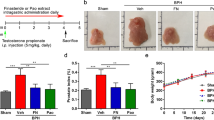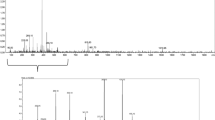Abstract
Since prostate growth is governed by the androgen signaling pathway, blockade of the pathway is regarded as an appropriate strategy for the treatment of benign prostatic hyperplasia (BPH). Panax ginseng is known to have various pharmacological activities. Of several products of its root, red ginseng, having many bioactive ginsenosides, is most popularly used in Korea, and recently has been reported to control the proliferation of cancer cells. We here tested the effect of a water extract of Korean red ginseng (WKRG) on testosterone-induced prostate hyperplasia. WKRG (daily intraperitoneal injection) prevented prostate overgrowth and epithelial thickening induced by testosterone in rats, and suppressed a rat prostate kallikrein-S3. In human prostate cells, WKRG inhibited testosterone-induced cell proliferation, arrested cell cycle by inducing p21 and p27, and induced apoptosis. Testosterone-induced expression of human kallikrein-3 mRNA and activation of androgen receptor (AR) were effectively inhibited by WKRG. Of the major ginsenosides included in WKRG, 20(S)-Rg3 was identified to repress AR activity and to attenuate prostate cell growth during testosterone stimulation. Moreover, 20(S)-Rg3 downregulated AR by facilitating the degradation of AR protein. WKRG and 20(S)-Rg3 were found to have new pharmacological activities against testosterone-induced prostate overgrowth. Given that red ginseng has been used safely in Asia for 1000 years, red ginseng and 20(S)-Rg3 could be potential therapeutic regimens for treating BPH.






Similar content being viewed by others

References
Lubahn DB, Joseph DR, Sar M, Tan J, Higgs HN, Larson RE, French FS, Wilson EM (1988) The human androgen receptor: complementary deoxyribonucleic acid cloning, sequence analysis and gene expression in prostate. Mol Endocrinol 2:1265–1275
Chatterjee B (2003) The role of the androgen receptor in the development of prostatic hyperplasia and prostate cancer. Mol Cell Biochem 253:89–101
Rittmaster RS (2008) 5alpha-reductase inhibitors in benign prostatic hyperplasia and prostate cancer risk reduction. Best Pract Res Clin Endocrinol Metab 22:389–402
Weisser H, Tunn S, Debus M, Krieg M (1994) 5Alpha-reductase inhibition by finasteride (Proscar) in epithelium and stroma of human benign prostatic hyperplasia. Steroids 59:616–620
Kim WY, Kim JM, Han SB, Lee SK, Kim ND, Park MK, Kim CK, Park JH (2000) Steaming of ginseng at high temperature enhances biological activity. J Nat Prod 63:1702–1704
Panax ginseng. Monograph (2009) Altern Med Rev 14:172–176
Yun TK, Lee YS, Lee YH, Kim SI, Yun HY (2001) Anticarcinogenic effect of Panax ginseng C.A. Meyer and identification of active compounds. J Korean Med Sci 16:S6–S18
Kim SN, Ha YW, Shin H, Son SH, Wu SJ, Kim YS (2007) Simultaneous quantification of 14 ginsenosides in Panax ginseng C.A. Meyer (Korean red ginseng) by HPLC-ELSD and its application to quality control. J Pharm Biomed Anal 45:164–170
Zhang XM, Qu SC, Sui DY, Yu XF, Lv ZZ (2004) Effects of ginsenoside-Rb on blood lipid metabolism and anti-oxidation in hyperlipidemia rats. Zhongguo Zhong Yao Za Zhi 29:1085–1088
Xie JT, Shao ZH, Vanden Hoek TL, Chang WT, Li J, Mehendale S, Wang CZ, Hsu CW, Becker LB, Yin JJ, Yuan CS (2006) Antioxidant effects of ginsenoside Re in cardiomyocytes. Eur J Pharmacol 532:201–207
Musende AG, Eberding A, Jia W, Ramsay E, Bally MB, Guns ET (2010) Rh2 or its aglycone aPPD in combination with docetaxel for treatment of prostate cancer. Prostate 70:1437–1447
Kim SM, Lee SY, Yuk DY, Moon DC, Choi SS, Kim Y, Han SB, Oh KW, Hong JT (2009) Inhibition of NF-kappaB by ginsenoside 20(S)-Rg3 enhances the susceptibility of colon cancer cells to docetaxel. Arch Pharm Res 32:755–765
Toda N, Ayajiki K, Fujioka H, Okamura T (2001) Ginsenoside potentiates NO-mediated neurogenic vasodilatation of monkey cerebral arteries. J Ethnopharmacol 76:109–113
Helms S (2004) Cancer prevention and therapeutics: Panax ginseng. Altern Med Rev 9:259–274
Yun TK (2003) Experimental and epidemiological evidence on non-organ specific cancer preventive effect of Korean ginseng and identification of active compounds. Mutat Res 523–524:63–74
Yun TK, Choi SY (1995) Preventive effect of ginseng intake against various human cancers—a case-control study on 1987 pairs. Cancer Epidem Biomarkers Prev 4:401–408
Yeo EJ, Chun YS, Cho YS, Kim J, Lee JC, Kim MS, Park JW (2003) YC-1: a potential anticancer drug targeting hypoxia-inducible factor 1. J Natl Cancer Inst 95:516–525
Schayowitz A, Sabnis G, Njar VC, Brodie AM (2008) Synergistic effect of a novel antiandrogen, VN/124-1, and signal transduction inhibitors in prostate cancer progression to hormone independence in vitro. Mol Cancer Ther 7:121–132
Kim J, Coetzee GA (2004) Prostate specific antigen gene regulation by androgen receptor. J Cell Biochem 93:233–241
Onozawa M, Fukuda K, Watanabe M, Ohtani M, Akaza H, Sugimora T, Wakabayashi K (2001) Detection and cloning of a protein recognized by anti-human prostate-specific antigen (PSA) antibody in the rat ventral prostate. Jpn J Cancer Res 92:863–868
Fujimoto N, Suzuki T, Ohta S, Kitamura S (2009) Identification of rat prostatic secreted proteins using mass spectrometric analysis and androgen-dependent mRNA expression. J Androl 30:669–678
Kim HS, Lee EH, Ko SR, Choi KJ, Park JH, Im DS (2004) Effects of ginsenosides 20(S)-Rg3 and Rh2 on the proliferation of prostate cancer cells. Arch Pharm Res 27:429–435
Wang W, Rayburn ER, Hao M, Zhao Y, Hill DL, Zhang R, Wang H (2008) Experimental therapy of prostate cancer with novel natural product anti-cancer ginsenosides. Prostate 68:809–819
Liu J, Shimizu K, Yu H, Zhang C, Jin F, Kondo R (2010) Stereospecificity of hydroxyl group at C-20 in antiproliferative action of ginsenoside Rh2 on prostate cancer cells. Fitoterapia 81:902–905
Leung KW, Pon YL, Wong RN, Wong AS (2006) Ginsenoside-Rg1 induces vascular endothelial growth factor expression through the glucocorticoid receptor-related phosphatidylinositol 3-kinase/Akt and beta-catenin/T-cell factor-dependent pathway in human endothelial cells. J Biol Chem 281:36280–36288
Leung KW, Leung FP, Huang Y, Mak NK, Wong RN (2007) Non-genomic effects of ginsenoside-Re in endothelial cells via glucocorticoid receptor. FEBS Lett 581:2423–2428
Cho J, Park W, Lee S, Ahn W, Lee Y (2004) Ginsenoside-Rb1 from Panax ginseng C.A. Meyer activates estrogen receptor-alpha and -beta, independent of ligand binding. J Clin Endocrinol Metab 89:3510–3515
Lee Y, Jin Y, Lim W, Ji S, Choi S, Jang S, Lee S (2003) A ginsenoside-Rh1, a component of ginseng saponin, activates estrogen receptor in human breast carcinoma MCF-7 cells. J Steroid Biochem Mol Biol 84:463–468
Hien TT, Kim ND, Pokharel YR, Oh SJ, Lee MY, Kang KW (2010) Ginsenoside Rg3 increases nitric oxide production via increases in phosphorylation and expression of endothelial nitric oxide synthase: Essential roles of estrogen receptor-dependent PI3-kinase and AMP-activated protein kinase. Toxicol Appl Pharmacol 246:171–183
Liu WK, Xu SX, Che CT (2000) Anti-proliferative effect of ginseng saponins on human prostate cancer cell line. Life Sci 67:1297–1306
Lin HK, Yeh S, Kang HY, Chang C (2001) Akt suppresses androgen-induced apoptosis by phosphorylating and inhibiting androgen receptor. Proc Natl Acad Sci USA 98:7200–7205
Wang L, Lin HK, Hu YC, Xie S, Yang L, Chang C (2004) Suppression of androgen receptor-mediated transactivation and cell growth by the glycogen synthase kinase 3 beta in prostate cells. J Biol Chem 279:32444–32452
Gioeli D, Black BE, Gordon V, Spencer A, Kesler CT, Eblen ST, Paschal BM, Weber MJ (2006) Stress kinase signaling regulates androgen receptor phosphorylation, transcription, and localization. Mol Endocrinol 20:503–515
Chen S, Xu Y, Yuan X, Bubley GJ, Balk SP (2006) Androgen receptor phosphorylation and stabilization in prostate cancer by cyclin-dependent kinase 1. Proc Natl Acad Sci USA 103:15969–15974
Lin HK, Wang L, Hu YC, Altuwaijri S, Chang C (2002) Phosphorylation-dependent ubiquitylation and degradation of androgen receptor by Akt require Mdm2 E3 ligase. EMBO J 21:4037–4048
Beduschi MC, Beduschi R, Oesterling JE (1998) Alpha-blockade therapy for benign prostatic hyperplasia: from a nonselective to a more selective alpha1A-adrenergic antagonist. Urology 51:861–872
Rosen RC, Giuliano F, Carson CC (2005) Sexual dysfunction and lower urinary tract symptoms (LUTS) associated with benign prostatic hyperplasia (BPH). Eur Urol 47:824–837
Gravas S, Oelke M (2010) Current status of 5alpha-reductase inhibitors in the management of lower urinary tract symptoms and BPH. World J Urol 28:9–15
Coon JT, Ernst E (2002) Panax ginseng: a systematic review of adverse effects and drug interactions. Drug Saf 25:323–344
Kim TH, Jeon SH, Hahn EJ, Paek KY, Park JK, Youn NY, Lee HL (2009) Effects of tissue-cultured mountain ginseng (Panax ginseng CA Meyer) extract on male patients with erectile dysfunction. Asian J Androl 11:356–361
Acknowledgments
This work was supported by a grant (2009) from the Korean Society of Ginseng funded by the Korean Ginseng Corporation, by the National Research Foundation of Korea grant funded by the Korea government (MESF) [No. 2011-0030737] and by a grant from the Seoul National University Hospital Research Fund 2010.
Author information
Authors and Affiliations
Corresponding author
Additional information
J.-S. Bae and H.-S. Park contributed equally to this work.
Electronic supplementary material
Below is the link to the electronic supplementary material.
Rights and permissions
About this article
Cite this article
Bae, JS., Park, HS., Park, JW. et al. Red ginseng and 20(S)-Rg3 control testosterone-induced prostate hyperplasia by deregulating androgen receptor signaling. J Nat Med 66, 476–485 (2012). https://doi.org/10.1007/s11418-011-0609-8
Received:
Accepted:
Published:
Issue Date:
DOI: https://doi.org/10.1007/s11418-011-0609-8



